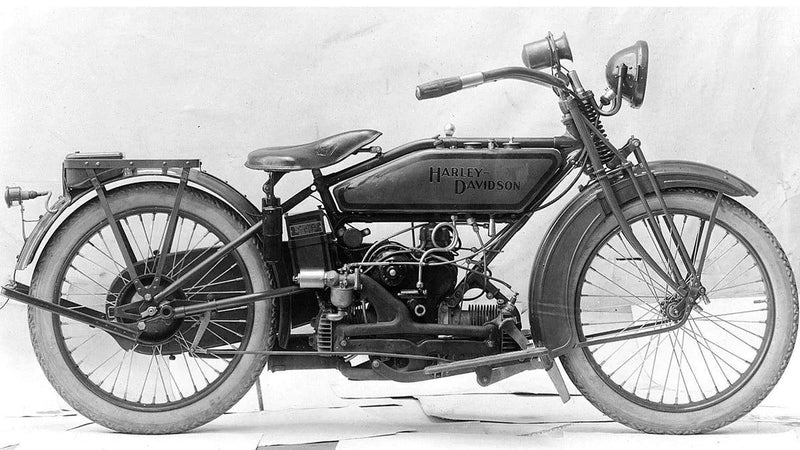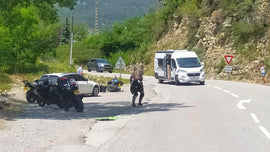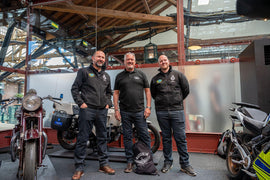
Harley-Davidson is more than a motorbike - it’s a way of life. A name recognised and revered the world over, its glorious motorcycles evoke freedom, speed and the lure of the open road. So how did it get here?
At 119 years old, this motorcycling phenomenon is part of popular culture, surviving world wars, depressions and rapid technological and engineering revolutions while leaving scores of competitors in the dust. Today, Harley-Davidson continues to inspire a special kind of loyalty among its customers, through building a global community and celebrating its own special story, which began in a small shed in Milwaukee, Wisconsin.

How did Harley-Davidson start up?
In 1903, brothers Walter and Arthur Davidson and their friend William Harley built a prototype of a loop-frame motorcycle in a small shed in the Davidson family’s backyard in Milwaukee, Wisconsin. It followed an earlier attempt by William and Arthur, who shared a passion for mechanics and design, to create a motorised bicycle. The new, larger and more powerful prototype took part in its first race in 1904 and was placed fourth. Harley-Davidson was born. Just five motorcycles were built in what has gone down in history as simply ‘The Shed’.
The company grew quickly, borrowing money from a Davidson uncle and finding its first dealer, Carl Lang. In 1906, the first Harley-Davidson factory opened. In 1908, police forces began buying and riding Harleys, attracted by their high quality and respectability, while in Chicago, Carl Lang organised the first motorcycle ride for his customers. Harley-Davidson introduced its first V-twin engine and when the First World War came, it supplied the US army with over 20,000 motorcycles.
 Harley-Davidson becomes the largest motorcycle manufacturer in the world
Harley-Davidson becomes the largest motorcycle manufacturer in the world
By 1920, Harley-Davidson had produced 28,189 machines and had dealers in 67 countries. In 1921, Otto Walker set a record on a Harley-Davidson as the first motorcycle to win a race at an average speed of over 100 mph.
Harley-Davidson's first overhead-valve engine, the Knucklehead, debuted in 1936. The company navigated its way through the Great Depression - one of only two American motorcycle makers to survive (Indian was the other). During the Second World War, Harley-Davidson manufactured more than 90,000 motorcycles for use by the U.S. military and its allies, cementing an enduring relationship between the two entities, visible today in HD’s military benefits programme.

Harley-Davidson motorcycles after the Second World War
The postwar decades brought diversification, successes and innovations but also controversy, cost-cutting and growing competition, especially from overseas. Harley-Davidson acquired the design of a small German motorcycle, the DKW RT 125, which they adapted and sold between 1948 and 1966. One model was the Hummer. An updated Knucklehead arrived for 1948. 1957 saw the introduction of the XL Sportster, while the Sixties and Seventies brought models including the Sprint and Bobcat. The FX Super Glide was Harley Davidson’s first ‘factory custom’ motorcycle and precursor to models including the present-day Softail Deuce.
In 1969, the film Easy Rider showcased Harleys on the big screen, instantly popularising the chopper. If the Harley-Davidson name wasn’t iconic already, it was now. However, overseas competition was unrelenting and that same year, Harley-Davidson merged with sporting-goods manufacturer American Machine and Foundry (AMF), to keep itself afloat. 1971 saw the launch of the FX Super Glide but trading remained tough. It took HD management buying back the business in 1981 to usher in a new era of engineering innovations, including the Evolution V-twin engine and the first Softail model.
In 1983, the company launched the HOG (Harley Owners Group), creating a club of like-minded riders bound together by their dedication to their Harley-Davidson motorcycles and a shared love of riding.
 Harley-Davidson today and tomorrow
Harley-Davidson today and tomorrow
Harley-Davidson’s brand recognition is the envy of the world. Doubtless this is partly due to its longevity, but also its heritage, which it cherishes and celebrates, not least via its museum in Milwaukee. HD’s HQ is still on the site of its first factory on Juneau Avenue. The HOG has over one million members worldwide, with events, magazines, merchandise, rallies and rides that create a fantastic customer experience. Simultaneously, it looks to the future, expanding into complementary businesses and embracing electric, including electric motorcycles and electric balance bikes for children. Worldwide retail sales of Harley-Davidson motorcycles increased by eight per cent between 2020 and 2021.

One strand of Harley-Davidson heritage can be traced back to Scotland. Last year, in a touching nod to the company’s origins, the new Sportster S was launched at Netherton Cottage, Angus, the home the Davidson family left in 1857 after deciding to emigrate to Wisconsin. It was the first Harley-Davidson launch outside of the USA. Not long ago, this traditional, stone-built cottage was falling down, but now it has been restored by enthusiasts with the aim of celebrating its famous family links and preserving it for future generations. It is now a magnet for Harley-Davidson fans from all over the world. The next chapter in the Harley-Davidson story is being written.
Read the 2nd part of this series - the Scottish cottage that’s part of motorcycling history.

